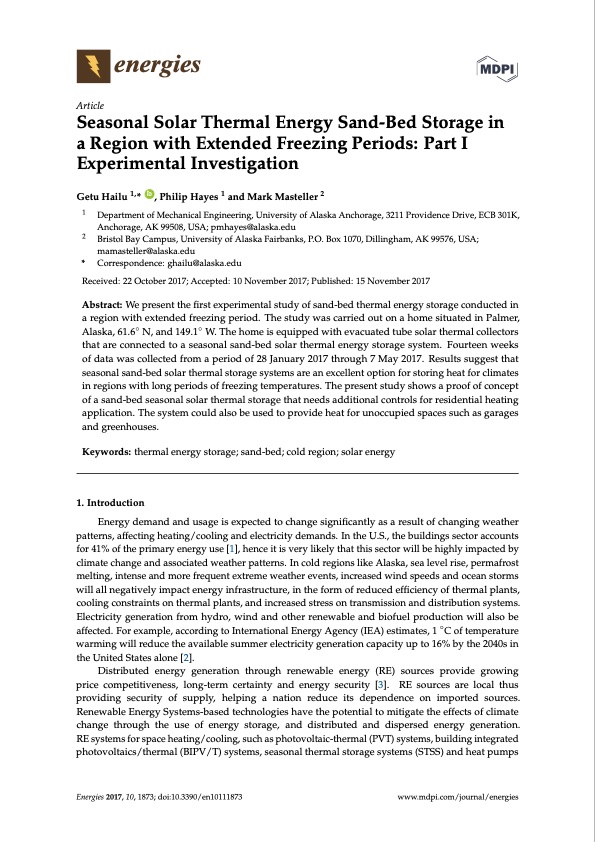
PDF Publication Title:
Text from PDF Page: 001
energies Article Seasonal Solar Thermal Energy Sand-Bed Storage in a Region with Extended Freezing Periods: Part I Experimental Investigation Getu Hailu 1,* ID , Philip Hayes 1 and Mark Masteller 2 1 2 * Correspondence: ghailu@alaska.edu Received: 22 October 2017; Accepted: 10 November 2017; Published: 15 November 2017 Abstract: We present the first experimental study of sand-bed thermal energy storage conducted in a region with extended freezing period. The study was carried out on a home situated in Palmer, Alaska, 61.6◦ N, and 149.1◦ W. The home is equipped with evacuated tube solar thermal collectors that are connected to a seasonal sand-bed solar thermal energy storage system. Fourteen weeks of data was collected from a period of 28 January 2017 through 7 May 2017. Results suggest that seasonal sand-bed solar thermal storage systems are an excellent option for storing heat for climates in regions with long periods of freezing temperatures. The present study shows a proof of concept of a sand-bed seasonal solar thermal storage that needs additional controls for residential heating application. The system could also be used to provide heat for unoccupied spaces such as garages and greenhouses. Keywords: thermal energy storage; sand-bed; cold region; solar energy 1. Introduction Energy demand and usage is expected to change significantly as a result of changing weather patterns, affecting heating/cooling and electricity demands. In the U.S., the buildings sector accounts for 41% of the primary energy use [1], hence it is very likely that this sector will be highly impacted by climate change and associated weather patterns. In cold regions like Alaska, sea level rise, permafrost melting, intense and more frequent extreme weather events, increased wind speeds and ocean storms will all negatively impact energy infrastructure, in the form of reduced efficiency of thermal plants, cooling constraints on thermal plants, and increased stress on transmission and distribution systems. Electricity generation from hydro, wind and other renewable and biofuel production will also be affected. For example, according to International Energy Agency (IEA) estimates, 1 ◦C of temperature warming will reduce the available summer electricity generation capacity up to 16% by the 2040s in the United States alone [2]. Distributed energy generation through renewable energy (RE) sources provide growing price competitiveness, long-term certainty and energy security [3]. RE sources are local thus providing security of supply, helping a nation reduce its dependence on imported sources. Renewable Energy Systems-based technologies have the potential to mitigate the effects of climate change through the use of energy storage, and distributed and dispersed energy generation. RE systems for space heating/cooling, such as photovoltaic-thermal (PVT) systems, building integrated photovoltaics/thermal (BIPV/T) systems, seasonal thermal storage systems (STSS) and heat pumps Department of Mechanical Engineering, University of Alaska Anchorage, 3211 Providence Drive, ECB 301K, Anchorage, AK 99508, USA; pmhayes@alaska.edu Bristol Bay Campus, University of Alaska Fairbanks, P.O. Box 1070, Dillingham, AK 99576, USA; mamasteller@alaska.edu Energies 2017, 10, 1873; doi:10.3390/en10111873 www.mdpi.com/journal/energiesPDF Image | Seasonal Solar Thermal Energy Sand-Bed Storage in Alaska

PDF Search Title:
Seasonal Solar Thermal Energy Sand-Bed Storage in AlaskaOriginal File Name Searched:
energies-10-01873-v2.pdfDIY PDF Search: Google It | Yahoo | Bing
Turbine and System Plans CAD CAM: Special for this month, any plans are $10,000 for complete Cad/Cam blueprints. License is for one build. Try before you buy a production license. More Info
Waste Heat Power Technology: Organic Rankine Cycle uses waste heat to make electricity, shaft horsepower and cooling. More Info
All Turbine and System Products: Infinity Turbine ORD systems, turbine generator sets, build plans and more to use your waste heat from 30C to 100C. More Info
CO2 Phase Change Demonstrator: CO2 goes supercritical at 30 C. This is a experimental platform which you can use to demonstrate phase change with low heat. Includes integration area for small CO2 turbine, static generator, and more. This can also be used for a GTL Gas to Liquids experimental platform. More Info
Introducing the Infinity Turbine Products Infinity Turbine develops and builds systems for making power from waste heat. It also is working on innovative strategies for storing, making, and deploying energy. More Info
Need Strategy? Use our Consulting and analyst services Infinity Turbine LLC is pleased to announce its consulting and analyst services. We have worked in the renewable energy industry as a researcher, developing sales and markets, along with may inventions and innovations. More Info
Made in USA with Global Energy Millennial Web Engine These pages were made with the Global Energy Web PDF Engine using Filemaker (Claris) software.
Sand Battery Sand and Paraffin for TES Thermo Energy Storage More Info
| CONTACT TEL: 608-238-6001 Email: greg@infinityturbine.com | RSS | AMP |